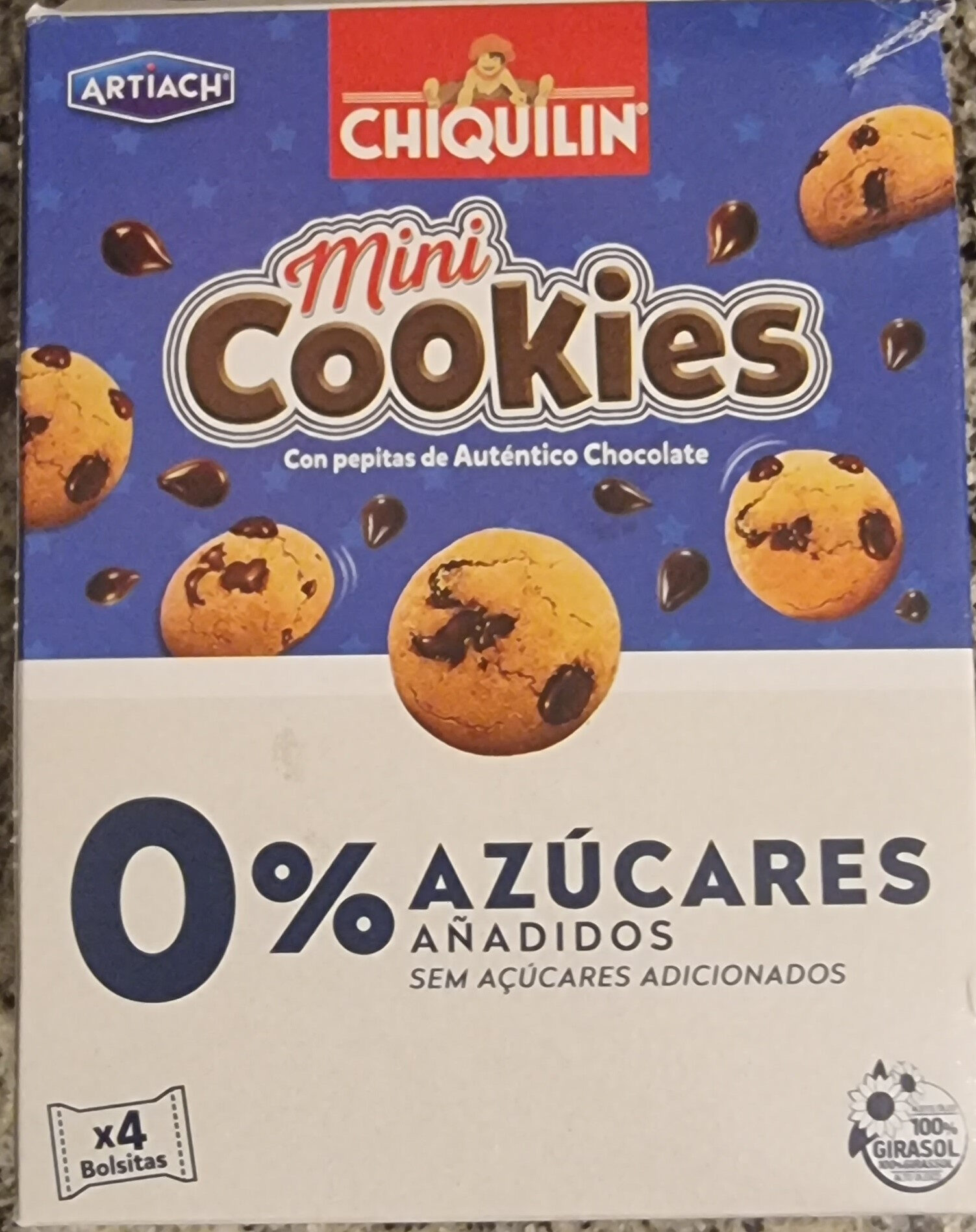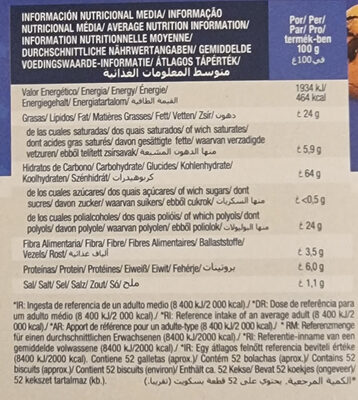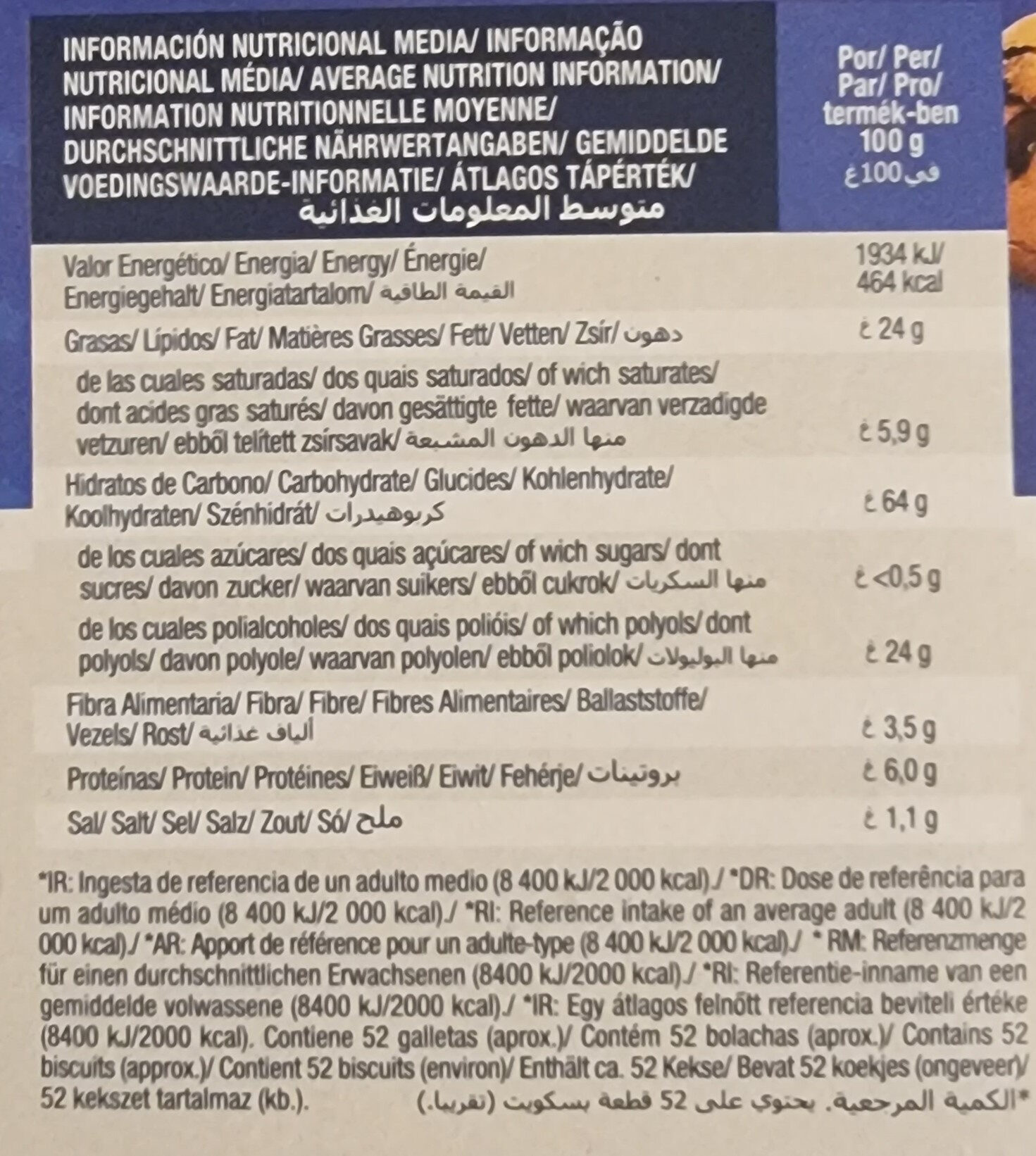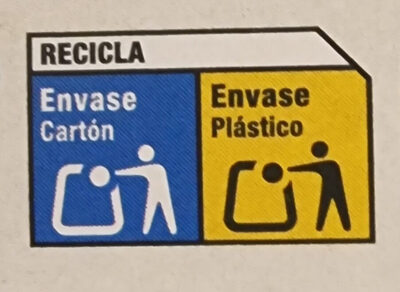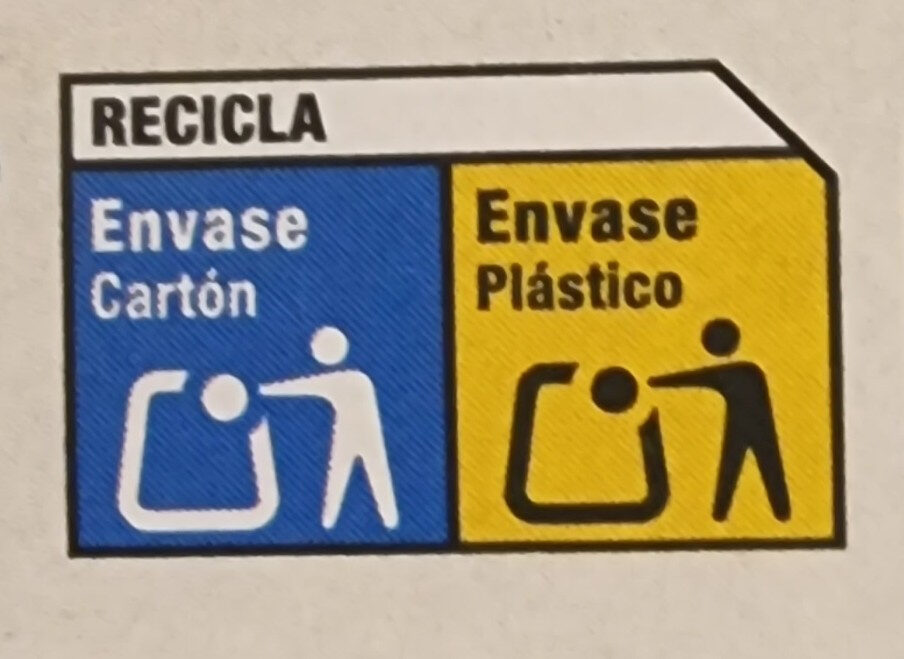Help us make food transparency the norm!
As a non-profit organization, we depend on your donations to continue informing consumers around the world about what they eat.
The food revolution starts with you!
Mini Cookies - Artiach - 120 g (4 Saquetas)
Mini Cookies - Artiach - 120 g (4 Saquetas)
This product page is not complete. You can help to complete it by editing it and adding more data from the photos we have, or by taking more photos using the app for Android or iPhone/iPad. Thank you!
×
Barra-kodea: 8436048961256 (EAN / EAN-13)
Kopurua: 120 g (4 Saquetas)
Ontziratzea: en:Plastic, en:Cardboard, es:Envase en cartón
Markak: Artiach, Chiquilin, Galletas Artiach
Kategoriak: en:Snacks, en:Sweet snacks, en:Biscuits and cakes, Gaileta, en:Chocolate biscuits, en:Drop cookies, en:Wafers
Etiketak, ziurtagiriak, sariak:
No added sugar, pt:100-girassol, pt:Ecoponto-amarelo, pt:Ecoponto-azul

Dendak: Continente
Saltzen diren herrialdeak: Frantzia, Maroko, Portugal, Espainia
Matching with your preferences
Health
Osagaiak
-
26 ingredients
: Farinha de TRIGO, chocolate com edulcorante 20% (pasta de cacau, edulcorante: maltitol, manteiga de cacau, cacau magro em pó, emulsionantes: lecitina de girassol, E 476, aroma), óleo de girassol alto oleico (18%), edulcorante (maltitol), levedantes (carbonatos de sódio e de amónio), xarope de fruto-oligossacarídeos, sal, aromas, antioxidantes (E-304, E 306), emulsionante: lecitina (contém _TRIGO)_.Alergenoak: en:GlutenAztarnak: en:Eggs, en:Milk, en:Nuts, en:Soybeans
Food processing
-
Ultra processed foods
Elements that indicate the product is in the 4 - Ultra prozesatutako elikagaiak eta edariak group:
- Gehigarria: E322
- Gehigarria: E476
- Gehigarria: E965
- Osagaia: Emulsifier
- Osagaia: Flavouring
- Osagaia: Sweetener
Food products are classified into 4 groups according to their degree of processing:
- Prozesatu gabeko edo ahalik eta gutxien prozesatutako elikagaiak
- Sukaldaritzako osagaiak prozesatu
- Prozesatutako jakiak
- Ultra processed foods
The determination of the group is based on the category of the product and on the ingredients it contains.
Gehigarriak
-
E304
Ascorbyl palmitate: Ascorbyl palmitate is an ester formed from ascorbic acid and palmitic acid creating a fat-soluble form of vitamin C. In addition to its use as a source of vitamin C, it is also used as an antioxidant food additive -E number E304-. It is approved for use as a food additive in the EU, the U.S., Canada, Australia, and New Zealand.Ascorbyl palmitate is known to be broken down -through the digestive process- into ascorbic acid and palmitic acid -a saturated fatty acid- before being absorbed into the bloodstream. Ascorbyl palmitate is also marketed as "vitamin C ester".Source: Wikipedia (Ingeles)
-
E322
Lecithin: Lecithin -UK: , US: , from the Greek lekithos, "egg yolk"- is a generic term to designate any group of yellow-brownish fatty substances occurring in animal and plant tissues, which are amphiphilic – they attract both water and fatty substances -and so are both hydrophilic and lipophilic-, and are used for smoothing food textures, dissolving powders -emulsifying-, homogenizing liquid mixtures, and repelling sticking materials.Lecithins are mixtures of glycerophospholipids including phosphatidylcholine, phosphatidylethanolamine, phosphatidylinositol, phosphatidylserine, and phosphatidic acid.Lecithin was first isolated in 1845 by the French chemist and pharmacist Theodore Gobley. In 1850, he named the phosphatidylcholine lécithine. Gobley originally isolated lecithin from egg yolk—λέκιθος lekithos is "egg yolk" in Ancient Greek—and established the complete chemical formula of phosphatidylcholine in 1874; in between, he had demonstrated the presence of lecithin in a variety of biological matters, including venous blood, in human lungs, bile, human brain tissue, fish eggs, fish roe, and chicken and sheep brain. Lecithin can easily be extracted chemically using solvents such as hexane, ethanol, acetone, petroleum ether, benzene, etc., or extraction can be done mechanically. It is usually available from sources such as soybeans, eggs, milk, marine sources, rapeseed, cottonseed, and sunflower. It has low solubility in water, but is an excellent emulsifier. In aqueous solution, its phospholipids can form either liposomes, bilayer sheets, micelles, or lamellar structures, depending on hydration and temperature. This results in a type of surfactant that usually is classified as amphipathic. Lecithin is sold as a food additive and dietary supplement. In cooking, it is sometimes used as an emulsifier and to prevent sticking, for example in nonstick cooking spray.Source: Wikipedia (Ingeles)
-
E322i - Lezitina
Lecithin: Lecithin -UK: , US: , from the Greek lekithos, "egg yolk"- is a generic term to designate any group of yellow-brownish fatty substances occurring in animal and plant tissues, which are amphiphilic – they attract both water and fatty substances -and so are both hydrophilic and lipophilic-, and are used for smoothing food textures, dissolving powders -emulsifying-, homogenizing liquid mixtures, and repelling sticking materials.Lecithins are mixtures of glycerophospholipids including phosphatidylcholine, phosphatidylethanolamine, phosphatidylinositol, phosphatidylserine, and phosphatidic acid.Lecithin was first isolated in 1845 by the French chemist and pharmacist Theodore Gobley. In 1850, he named the phosphatidylcholine lécithine. Gobley originally isolated lecithin from egg yolk—λέκιθος lekithos is "egg yolk" in Ancient Greek—and established the complete chemical formula of phosphatidylcholine in 1874; in between, he had demonstrated the presence of lecithin in a variety of biological matters, including venous blood, in human lungs, bile, human brain tissue, fish eggs, fish roe, and chicken and sheep brain. Lecithin can easily be extracted chemically using solvents such as hexane, ethanol, acetone, petroleum ether, benzene, etc., or extraction can be done mechanically. It is usually available from sources such as soybeans, eggs, milk, marine sources, rapeseed, cottonseed, and sunflower. It has low solubility in water, but is an excellent emulsifier. In aqueous solution, its phospholipids can form either liposomes, bilayer sheets, micelles, or lamellar structures, depending on hydration and temperature. This results in a type of surfactant that usually is classified as amphipathic. Lecithin is sold as a food additive and dietary supplement. In cooking, it is sometimes used as an emulsifier and to prevent sticking, for example in nonstick cooking spray.Source: Wikipedia (Ingeles)
-
E476
Polyglycerol polyricinoleate: Polyglycerol polyricinoleate -PGPR-, E476, is an emulsifier made from glycerol and fatty acids -usually from castor bean, but also from soybean oil-. In chocolate, compound chocolate and similar coatings, PGPR is mainly used with another substance like lecithin to reduce viscosity. It is used at low levels -below 0.5%-, and works by decreasing the friction between the solid particles -e.g. cacao, sugar, milk- in molten chocolate, reducing the yield stress so that it flows more easily, approaching the behaviour of a Newtonian fluid. It can also be used as an emulsifier in spreads and in salad dressings, or to improve the texture of baked goods. It is made up of a short chain of glycerol molecules connected by ether bonds, with ricinoleic acid side chains connected by ester bonds. PGPR is a yellowish, viscous liquid, and is strongly lipophilic: it is soluble in fats and oils and insoluble in water and ethanol.Source: Wikipedia (Ingeles)
-
E965
Maltitol: Maltitol is a sugar alcohol -a polyol- used as a sugar substitute. It has 75–90% of the sweetness of sucrose -table sugar- and nearly identical properties, except for browning. It is used to replace table sugar because it is half as caloric, does not promote tooth decay, and has a somewhat lesser effect on blood glucose. In chemical terms, maltitol is known as 4-O-α-glucopyranosyl-D-sorbitol. It is used in commercial products under trade names such as Lesys, Maltisweet and SweetPearl.Source: Wikipedia (Ingeles)
Ingredients analysis
-
en:May contain palm oil
Ingredients that may contain palm oil: E304
-
en:Vegan status unknown
Unrecognized ingredients: pt:chocolate-com-edulcorante, pt:oleo-de-girassol-alto-oleico, pt:carbonatos-de-sodio-e-de-amonio, pt:xarope-de-fruto-oligossacarideos, pt:Some ingredients could not be recognized.
We need your help!
You can help us recognize more ingredients and better analyze the list of ingredients for this product and others:
- Edit this product page to correct spelling mistakes in the ingredients list, and/or to remove ingredients in other languages and sentences that are not related to the ingredients.
- Add new entries, synonyms or translations to our multilingual lists of ingredients, ingredient processing methods, and labels.
If you would like to help, join the #ingredients channel on our Slack discussion space and/or learn about ingredients analysis on our wiki. Thank you!
-
en:Vegetarian status unknown
Unrecognized ingredients: pt:chocolate-com-edulcorante, pt:oleo-de-girassol-alto-oleico, pt:carbonatos-de-sodio-e-de-amonio, pt:xarope-de-fruto-oligossacarideos, pt:Some ingredients could not be recognized.
We need your help!
You can help us recognize more ingredients and better analyze the list of ingredients for this product and others:
- Edit this product page to correct spelling mistakes in the ingredients list, and/or to remove ingredients in other languages and sentences that are not related to the ingredients.
- Add new entries, synonyms or translations to our multilingual lists of ingredients, ingredient processing methods, and labels.
If you would like to help, join the #ingredients channel on our Slack discussion space and/or learn about ingredients analysis on our wiki. Thank you!
-
Details of the analysis of the ingredients
We need your help!
Some ingredients could not be recognized.
We need your help!
You can help us recognize more ingredients and better analyze the list of ingredients for this product and others:
- Edit this product page to correct spelling mistakes in the ingredients list, and/or to remove ingredients in other languages and sentences that are not related to the ingredients.
- Add new entries, synonyms or translations to our multilingual lists of ingredients, ingredient processing methods, and labels.
If you would like to help, join the #ingredients channel on our Slack discussion space and/or learn about ingredients analysis on our wiki. Thank you!
: Farinha de _TRIGO_, chocolate com edulcorante 20% (pasta de cacau, edulcorante (maltitol), manteiga de cacau, cacau magro em pó, emulsionantes (lecitina de girassol), e476, aroma), óleo de girassol alto oleico 18%, edulcorante (maltitol), levedantes (carbonatos de sódio e de amónio), xarope de fruto-oligossacarídeos, sal, aromas, antioxidantes (e304, e306), emulsionante (lecitina (contém _TRIGO), _)- Farinha de _TRIGO_ -> en:wheat-flour - vegan: yes - vegetarian: yes - ciqual_proxy_food_code: 9410 - percent_min: 20 - percent_max: 62
- chocolate com edulcorante -> pt:chocolate-com-edulcorante - percent_min: 20 - percent: 20 - percent_max: 20
- pasta de cacau -> en:cocoa-paste - vegan: yes - vegetarian: yes - ciqual_proxy_food_code: 16030 - percent_min: 2.85714285714286 - percent_max: 20
- edulcorante -> en:sweetener - percent_min: 0 - percent_max: 10
- maltitol -> en:e965 - vegan: yes - vegetarian: yes - percent_min: 0 - percent_max: 10
- manteiga de cacau -> en:cocoa-butter - vegan: yes - vegetarian: yes - ciqual_food_code: 16030 - percent_min: 0 - percent_max: 6.66666666666667
- cacau magro em pó -> en:fat-reduced-cocoa-powder - vegan: yes - vegetarian: yes - ciqual_food_code: 18100 - percent_min: 0 - percent_max: 5
- emulsionantes -> en:emulsifier - percent_min: 0 - percent_max: 4
- lecitina de girassol -> en:sunflower-lecithin - vegan: yes - vegetarian: yes - percent_min: 0 - percent_max: 4
- e476 -> en:e476 - vegan: yes - vegetarian: yes - percent_min: 0 - percent_max: 3.33333333333333
- aroma -> en:flavouring - vegan: maybe - vegetarian: maybe - percent_min: 0 - percent_max: 2.85714285714286
- óleo de girassol alto oleico -> pt:oleo-de-girassol-alto-oleico - percent_min: 18 - percent: 18 - percent_max: 18
- edulcorante -> en:sweetener - percent_min: 0 - percent_max: 18
- maltitol -> en:e965 - vegan: yes - vegetarian: yes - percent_min: 0 - percent_max: 18
- levedantes -> en:raising-agent - percent_min: 0 - percent_max: 18
- carbonatos de sódio e de amónio -> pt:carbonatos-de-sodio-e-de-amonio - percent_min: 0 - percent_max: 18
- xarope de fruto-oligossacarídeos -> pt:xarope-de-fruto-oligossacarideos - percent_min: 0 - percent_max: 15
- sal -> en:salt - vegan: yes - vegetarian: yes - ciqual_food_code: 11058 - percent_min: 0 - percent_max: 1.1
- aromas -> en:flavouring - vegan: maybe - vegetarian: maybe - percent_min: 0 - percent_max: 1.1
- antioxidantes -> en:antioxidant - percent_min: 0 - percent_max: 1.1
- e304 -> en:e304 - vegan: maybe - vegetarian: maybe - from_palm_oil: maybe - percent_min: 0 - percent_max: 1.1
- e306 -> en:e306 - vegan: yes - vegetarian: yes - percent_min: 0 - percent_max: 0.55
- emulsionante -> en:emulsifier - percent_min: 0 - percent_max: 1.1
- lecitina -> en:e322i - vegan: maybe - vegetarian: maybe - percent_min: 0 - percent_max: 1.1
- contém _TRIGO -> en:wheat - vegan: yes - vegetarian: yes - ciqual_proxy_food_code: 9410 - percent_min: 0 - percent_max: 1.1
- _ -> pt: - percent_min: 0 - percent_max: 0.55
- lecitina -> en:e322i - vegan: maybe - vegetarian: maybe - percent_min: 0 - percent_max: 1.1
Elikadura
-
Poor nutritional quality
⚠ ️Warning: the amount of fruits, vegetables and nuts is not specified on the label, it was estimated from the list of ingredients: 0This product is not considered a beverage for the calculation of the Nutri-Score.
Positive points: 3
- Proteinak: 3 / 5 (balioa: 6, rounded value: 6)
- Fiber: 3 / 5 (balioa: 3.5, rounded value: 3.5)
- Fruits, vegetables, nuts, and colza/walnut/olive oils: 0 / 5 (balioa: 0, rounded value: 0)
Negative points: 14
- Energia: 5 / 10 (balioa: 1934, rounded value: 1934)
- Azukreak: 0 / 10 (balioa: 0.5, rounded value: 0.5)
- Gantz saturatua: 5 / 10 (balioa: 5.9, rounded value: 5.9)
- Sodioa: 4 / 10 (balioa: 440, rounded value: 440)
The points for proteins are not counted because the negative points are greater or equal to 11.
Nutritional score: (14 - 3)
Nutri-Score:
-
Nutrient levels
-
Koipe in high quantity (24%)
What you need to know- A high consumption of fat, especially saturated fats, can raise cholesterol, which increases the risk of heart diseases.
Recommendation: Limit the consumption of fat and saturated fat- Choose products with lower fat and saturated fat content.
-
Gantz-azido ase in high quantity (5.9%)
What you need to know- A high consumption of fat, especially saturated fats, can raise cholesterol, which increases the risk of heart diseases.
Recommendation: Limit the consumption of fat and saturated fat- Choose products with lower fat and saturated fat content.
-
Azukre in low quantity (0.5%)
What you need to know- A high consumption of sugar can cause weight gain and tooth decay. It also augments the risk of type 2 diabetes and cardio-vascular diseases.
Recommendation: Limit the consumption of sugar and sugary drinks- Sugary drinks (such as sodas, fruit beverages, and fruit juices and nectars) should be limited as much as possible (no more than 1 glass a day).
- Choose products with lower sugar content and reduce the consumption of products with added sugars.
-
Gatz arrunt in moderate quantity (1.1%)
What you need to know- A high consumption of salt (or sodium) can cause raised blood pressure, which can increase the risk of heart disease and stroke.
- Many people who have high blood pressure do not know it, as there are often no symptoms.
- Most people consume too much salt (on average 9 to 12 grams per day), around twice the recommended maximum level of intake.
Recommendation: Limit the consumption of salt and salted food- Reduce the quantity of salt used when cooking, and don't salt again at the table.
- Limit the consumption of salty snacks and choose products with lower salt content.
-
-
Nutrition facts
Nutrition facts As sold
for 100 g / 100 mlAs sold
per serving (2,3 g)Compared to: en:Drop cookies Energia 1.934 kj
(464 kcal)44,5 kj
(10 kcal)-% 5 Koipe 24 g 0,552 g +% 4 Gantz-azido ase 5,9 g 0,136 g -% 42 Carbohydrates 64 g 1,47 g +% 4 Azukre 0,5 g 0,012 g -% 98 Polyols 24 g 0,552 g Fiber 3,5 g 0,08 g -% 9 Proteina 6 g 0,138 g -% 0 Gatz arrunt 1,1 g 0,025 g +% 87 Fruits‚ vegetables‚ nuts and rapeseed‚ walnut and olive oils (estimate from ingredients list analysis) 0 % 0 %
Ingurumena
-
Eco-Score C - Moderate environmental impact
The Eco-Score is an experimental score that summarizes the environmental impacts of food products.→ The Eco-Score was initially developped for France and it is being extended to other European countries. The Eco-Score formula is subject to change as it is regularly improved to make it more precise and better suited to each country.Life cycle analysis
-
Average impact of products of the same category: B (Score: 77/100)
Kategoria: Wafer biscuit, crunchy (thin or dry), plain or with sugar, prepacked
Kategoria: Wafer biscuit, crunchy (thin or dry), plain or with sugar, prepacked
- PEF environmental score: 0.30 (the lower the score, the lower the impact)
- including impact on climate change: 2.47 kg CO2 eq/kg of product
Stage Impact Agriculture
75.8 %Processing
12.6 %Ontziratzea
6.4 %Transportation
3.6 %Distribution
1.6 %Consumption
0.0 %
Bonuses and maluses
-
Missing origins of ingredients information
Malus: -5
⚠ ️ The origins of the ingredients of this product are not indicated.
If they are indicated on the packaging, you can modify the product sheet and add them.
If you are the manufacturer of this product, you can send us the information with our free platform for producers.
-
Missing packaging information for this product
Malus: -15
⚠ ️ The information about the packaging of this product is not filled in.⚠ ️ For a more precise calculation of the Eco-Score, you can modify the product page and add them.
If you are the manufacturer of this product, you can send us the information with our free platform for producers.
Eco-Score for this product
-
Impact for this product: C (Score: 57/100)
Produktua: Mini Cookies - Artiach - 120 g (4 Saquetas)
Life cycle analysis score: 77
Sum of bonuses and maluses: -20
Final score: 57/100
-
Carbon footprint
-
Equal to driving 1.3 km in a petrol car
247 g CO² per 100g of product
The carbon emission figure comes from ADEME's Agribalyse database, for the category: Wafer biscuit, crunchy (thin or dry), plain or with sugar, prepacked (Source: ADEME Agribalyse Database)
Stage Impact Agriculture
74.3 %Processing
7.9 %Ontziratzea
11.7 %Transportation
5.3 %Distribution
0.8 %Consumption
0.0 %
Ontziratzea
-
Missing packaging information for this product
⚠ ️ The information about the packaging of this product is not filled in.Take a photo of the recycling information Take a photo of the recycling information
Transportation
-
Origins of ingredients
Missing origins of ingredients information
⚠ ️ The origins of the ingredients of this product are not indicated.
If they are indicated on the packaging, you can modify the product sheet and add them.
If you are the manufacturer of this product, you can send us the information with our free platform for producers.Add the origins of ingredients for this product Add the origins of ingredients for this product
Report a problem
-
Incomplete or incorrect information?
Category, labels, ingredients, allergens, nutritional information, photos etc.
If the information does not match the information on the packaging, please complete or correct it. Open Food Facts is a collaborative database, and every contribution is useful for all.
Datuen iturria
Product added on by kiliweb
Last edit of product page on by isabel626.
Produktuaren orria -gatik editatua marunsky, musarana, openfoodfacts-contributors, paularm, roboto-app, scanbot, yuka.WVlGYkg0OEdwL0lqbHNZMHhUL0VwZHRuL3J1QVdUbVljZFVqSVE9PQ.

